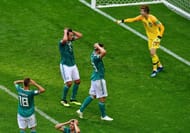
The World Cup Champion’s curse has struck once more as Germany crashed out of this edition of the competition, as defending champions have before them in 2014, 2010 and 2002. But was it really destiny or was this a long time coming for the reigning World Champions?
The Germans qualified for the 2018 World Cup through an undefeated qualifying campaign having topped Group C with the maximum possible points and scoring an impressive 43 goals against the likes of Northern Ireland, Czech Republic, Norway, Azerbaijan and San Marino. In addition to this, they only conceded 4 goals as they geared up to defend their World Crown.
The Confederations Test
The Germans had an impressive FIFA Confederations Cup victory last summer, with what we could claim was their B team. With the likes of Leon Goretzka, Timo Werner and Julian Draxler all starring in this pre World Cup tournament, it seemed as though Germany’s future was bright.

Joachim Löw showed his tactical flexibility by switching to a three-man backline. He made use of Goretzka’s versatility by either deploying him in central midfield alongside the more defensive Sebastian Rudy or in a more advanced role with Rudy and Emre Can shielding the defence. Goretzka ended the tournament with a joint top goal tally of 3 goals alongside teammates Werner and Lars Stindl. Draxler was another player with an impressive campaign having started every game of the tournament; he was deployed on the left wing, a position he retained for the World Cup, but with less success.
The 3-4-3 system that the Germans used to great effect during the Confederations Cup seemed like the most stable formation that suited all available players while the Germans still had first-team players like Toni Kroos, Mats Hummels, Jérôme Boateng and Mesut Özil to call up.
The Ineffective German System
Germany’s performances in the friendlies during the run-up to this tournament were lacklustre. With losses to Brazil and Austria, and a 1-1 draw to Spain, the Germans' only victory was against Saudi Arabia – where an own goal sealed Germany’s victory.
The general belief on the eve of the tournament was that Germany usually kicks into gear when the competitive fixtures start. But having struggled and lost against both Mexico and South Korea and won through an injury-time Kroos winner (albeit a brilliant freekick) against Sweden, Die Mannschaft's title defence ended even before it started.

Löw made use of the 4-2-3-1 formation for the group games with a double pivot of Kroos partnered by either Sami Khedira or Rudy. The cracks in this system were seen in their opening encounter with Mexico, who the Germans had dismantled 4-1 in the Confederations Cup Semi-Finals. Mexico played an exciting 90 minutes of counterattacking football, constantly bypassing the German midfield with long balls and catching the defence off guard.
Probably one of the biggest misses to this side was Bastian Schweinsteiger - who was an integral part of the 2014 world cup winning squad - providing the necessary cover for Kroos to roam ahead. Against Mexico, the German midfield was in shambles, constantly caught sleeping and putting their centre-backs in 1v1 and 2v2 situations. This was because of the lack of pace in the double pivot, making it hard for the players to track back and provide ample back cover.
Especially with the roaming tendencies of both Khedira and Kroos, their combined lack of pace left their side vulnerable to Mexican counters. The Mexicans, to their credit, set up brilliantly and countered at will, where their defence could regularly pick out long balls to the forwards who invariably found themselves in favourable attacking positions.
In all three group games, another worrisome trend emerged; the German attack lacked creativity and the ability to produce those moments of brilliance that can open up any defence. This was partially due to the diligent defending by their opponents - often placed in medium to low blocks, always trying to deny Germany the space to create.
Pressing was another tactic used efficiently by Germany's opponents to great effect, as was the closing marking of Kroos - the player who the Germans look to for setting the tempo, picking out passes and recycling possession. The German attack looked flat, predictable and boring, almost always resorting to crossing into the box and hoping for a finish.
The Germans may be down, but counting them out would be naïve. Perhaps an early exit would do them good, in preparation for their next big test – the 2020 European Championships. A serious revaluation of this team and its style must be made, Germany has the required talent and, as demonstrated in their Confederations Cup campaign, the necessary flexibility to bounce back as serious contenders for their next tournament. It is structural inefficiencies and a general lack of motivation that dictated their early exit this time and this must be addressed sooner rather than later by the upper echelons at the German camp.
